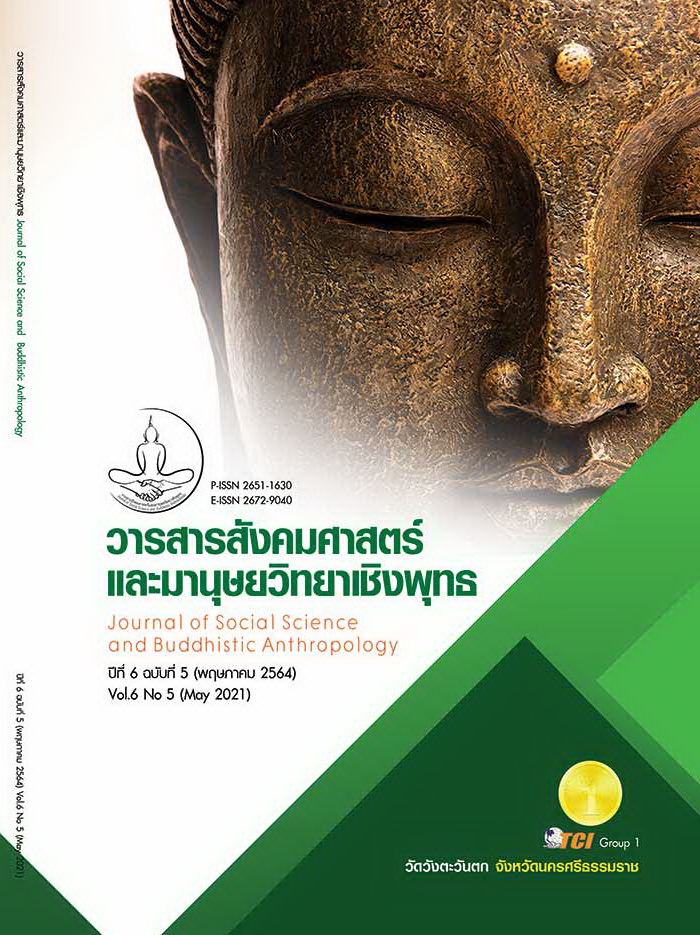THE BUDDHIST INTEGRATED MODEL OF ADMINISTRATION TOEXCELLENCE OF MAHAMAKUT BUDDHIST UNIVERSITY
Keywords:
Model, Buddhist Integrated, Administration to Excellence, Mahamakut Buddhist UniversityAbstract
The objectives of the research were 1) to study the factors and indicators of the Buddhist integrated model of administration towards excellence of Mahamakut Buddhist University, 2) test the adequacy of the model against the empirical data and construct, 3) create and assess the operation manual of the said model. The samples were totally 420 in number, together with 5 interviews and 9 consults. The rating scale questionnaire was employed for data collection and the test form was implemented for testing the factors and indicators. The statistical devices such as percentage, mean and standard deviation were used for data analysis, and for reliability and validity of the data, the exploratory, confirmatory, and ordinal correlation analyses for testing consistence in multi-lateral decision were also practiced. The findings showed the following: 1) The factors and indicators of the Buddhist integrated model of administration towards excellence of Mahamakut Buddhist University comprised 4 factors and 20 indicators. 2) The test of consistency of the model displayed χ2 = 178.398, df = 92, P – Value = 0.087, CFI = 0.937, TLI = 0.926, RMSEA = 0.063, SRMR = 0.048, and the structural validity and reliability existed (C.R.) at 0.988 exceeding 0.60, that featured the consistency with the empirical data. 3) The operation manual of the said model was found to show its usability at the ‘MUCH’ level, and the result of the ordinal correlation analysis for testing consistence in multi-lateral decision showed F to stand at 0.28. Which is less than 2.17, which is not in critical territory Therefore, the H0 main hypothesis cannot be rejected. Therefore, all 9 person have the same opinion.
References
กระทรวงการอุดมศึกษาวิทยาศาสตร์วิจัยและนวัตกรรม. (2562). นโยบายการดำเนินงานของกระทรวงการอุดมศึกษาวิทยาศาสตร์วิจัยและนวัตกรรมโดยรัฐมนตรีว่าการกระทรวงการอุดมศึกษาวิทยาศาสตร์วิจัยและนวัตกรรมในคราวการประชุมผู้บริหารกระทรวงการอุดมศึกษาวิทยาศาสตร์วิจัยและนวัตกรรม. เรียกใช้เมื่อ 19 กันยายน 2562 จาก https://www.mhesi.go.th/ home/images/2562/.pdf
พนิดา ดอนเมฆ. (2559). การพัฒนารูปแบบความสัมพันธ์เชิงสาเหตุของปัจจัยที่มีอิทธิพลต่อผลการดำเนินงานสู่ความเป็นเลิศของสถานศึกษาเอกชน ในจังหวัดระยอง. ใน วิทยานิพนธ์ครุศาสตรมหาบัณฑิต สาขาวิชาการบริหารการศึกษา. มหาวิทยาลัยราชภัฏรำไพพรรณี.
พระประเสริฐ วรธมฺโม (ธิลาว) และคณะ. (2559). พุทธบูรณาการการพัฒนาทุนมนุษย์สู่ความเป็นองค์กรสมรรถนะสูงของสถาบันการศึกษาระดับอุดมศึกษาของคณะสงฆ์ไทย. วารสาร มจร สังคมศาสตร์ปริทรรศน์, 5(1), 71 - 84.
พระมหาวีรศักดิ์ สุรเมธี และรองศาสตราจารย์ ดร.นรินทร์ชัย พัฒนพงศา. (2557). แนวทางการบูรการการเปลี่ยนแปลงของมหาวิทยาลัยมหามกุฏราชวิทยาลัยในทศวรรษหน้า. วารสารวิชาการมหาวิทยาลัยฟาร์อีสเทอร์น, 8(1), 143 - 153.
พระมหาสหัส ดำคุ้ม. (2556). การพัฒนารูปแบบการบริหารมหาวิทยาลัยมหาจุฬาลงกรณราชวิทยาลัยที่มีประสิทธิผล. ใน วิทยานิพนธ์ปรัชญาดุษฎีบัณฑิต สาขาวิชาบริหารการศึกษา. วิทยาลัยบัณฑิตศึกษาด้านการจัดการ มหาวิทยาลัยศรีปทุม.
พระวุฒิพงษ์ เพียรภูเขา และรองศาสตราจารย์ ดร.เพ็ญณี แนรอท. (2560). มุมมองด้านการบริหารจัดการของมหาวิทยาลัยมหาจุฬาลงกรณราชวิทยาลัย วิทยาเขตขอนแก่น สู่ความเป็นเลิศในทศวรรษหน้า. วารสารวิทยาลัยบัณฑิตเอเชีย, 7(2), 11 - 20.
มหาวิทยาลัยมหามกุฏราชวิทยาลัย. (2561). รายงานประจำปี 2560 มหาวิทยาลัยมหามกุฏราชวิทยาลัย. นครปฐม: มหาวิทยาลัยมหามกุฏราชวิทยาลัย.
รักเกียรติ หงษ์ทอง และคณะ. (2558). ประสิทธิผลขององค์การกับตัวแบบภาวะผู้นำเชิงวิสัยทัศน์ของคณะผู้บริหารมหาวิทยาลัยราชภัฏตะวันตก. วารสารวิชาการและวิจัยสังคมศาสตร์ มหาวิทยาลัยราชภัฏนครสวรรค์, 10(29), 71 - 86.
วาสนา เลิศมะเลา และเทพศักดิ์ บุณยรัตพันธุ์. (2561). การพัฒนาองค์การสู่ความเป็นเลิศของมหาวิทยาลัยราชภัฏในเขตพื้นที่ภาคตะวันออกเฉียงเหนือ. วารสารรัฐศาสตร์และรัฐประศาสนศาสตร์, 9(2), 209 - 248.
สำนักงานเลขานุการของคณะกรรมการยุทธศาสตร์ชาติ. (2562). การพัฒนาการเศรษฐกิจและสังคมแห่งชาติ. เรียกใช้เมื่อ 19 กันยายน 2562 จาก https://www.nesdb.go.th/ download/document/SAC/NS_SumPlanOct2018.pdf
สุภมาส อังศุโชติ และคณะ. (2551). สถิติการวิเคราะห์สำหรับการวิจัยทางสังคมศาสตร์และพฤติกรรมศาสตร์ เทคนิคการใช้โปรแกรม LISREL. กรุงเทพมหานคร: มิสชั่น มีเดีย.
Schumacker, R. E. & Lomaw, R. G. (2010). A beginner’s guide to structural equation modeling. New Jersey: Lawrence Erlbaum Associates.
Stufflebeam, D. L. & Shinkfiell, A. J. (2007). Evaluation : Theory, models and applications. San Francisco: Jossey-Bass.








